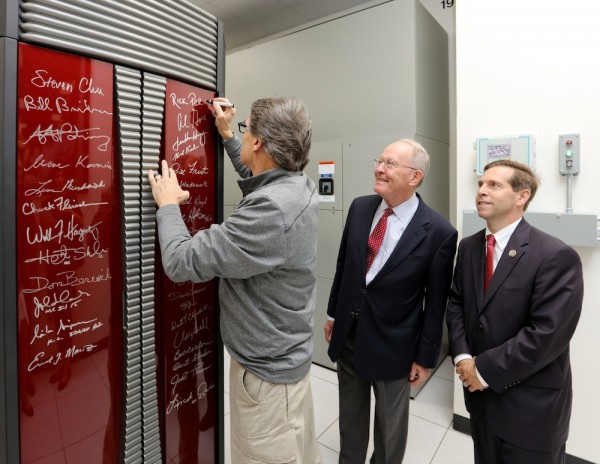
Energy Secretary Rick Perry drives a 3D-printed utility vehicle, or PUV, at Oak Ridge National Laboratory’s Manufacturing Demonstration Facility in Hardin Valley on Monday, May 22, 2017. His passenger is Craig Blue, director of energy efficiency and renewable energy programs at ORNL. (Photo by John Huotari/Oak Ridge Today)
Note: This story was last updated at 8:30 a.m. May 24.
HARDIN VALLEY—He once called for eliminating the U.S. Department of Energy, but after touring federal sites in Oak Ridge and Hardin Valley on Monday, new Energy Secretary Rick Perry pledged to be an advocate for at least some programs.
Perry, a former Texas governor who was confirmed as energy secretary on March 2, was asked about his comments calling for the elimination of three federal departments, including DOE, during the 2012 presidential campaign. His call to eliminate the three departments probably received more attention than it might have otherwise because, in a moment that received a lot of attention, Perry couldn’t recall the name of the Department of Energy during a November 2011 debate. Some believe that moment helped sink his presidential campaign.
Earlier this year, Perry told U.S. senators during his confirmation hearing that he regretted his earlier call to eliminate DOE. After being briefed on many vital functions of DOE, he no longer believed that it should be eliminated, Perry told the Senate Energy and Natural Resources Committee, according to The New York Times.
During a stop in Hardin Valley on Monday afternoon, Perry acknowledged he’s learned a lot since the 2012 campaign, including in his visit to Oak Ridge and at DOE headquarters in Washington, D.C., and in trips to Idaho National Laboratory and the Waste Isolation Pilot Plant in southeast New Mexico.
He suggested he might not be the only one unaware of some of the innovations that have roots in or are developed in places like Oak Ridge, innovations like gene therapy, supercomputing, and 3D printing. The American public may also not be aware of how that “cutting-edge” technology can be used to create jobs and wealth, Perry said.
“Those are things I readily admit I didn’t know five years ago,” Perry said after operating a 3D-printed excavator and test-driving a printed utility vehicle—and learning about other innovations such as supercomputers at Oak Ridge National Laboratory and composite work at its Manufacturing Demonstration Facility in Hardin Valley on Monday afternoon. “There are a lot of things that have surprised me.”
Several times, he pointed out the potential economic benefits, and he cited the important national security work occurring at sites like Oak Ridge.
“I will be a strong advocate for not only the funding of this but also the expansion of (it) in the places where it makes sense,” Perry said. America’s greatest days are ahead of it, and one of the main reasons is the national labs, Perry said.
His advocacy could be tested soon. In a preliminary budget blueprint released in March, President Donald Trump proposed cutting $900 million from the Office of Science in the next fiscal year, which begins October 1. That 17 percent reduction, if enacted, would likely affect ORNL, an Office of Science lab.
There is some concern at ORNL, but the original proposed cut of $900 million seems unlikely, ORNL Director Thom Mason said. He said there is bipartisan support for Office of Science work.
“I’m pretty confident that the lab will come through okay in the end,” said Mason, who is leaving the lab after 10 years to serve as senior vice president for laboratory operations at Battelle in Columbus, Ohio, starting July 1.
Some proposed DOE cuts could reach 50 percent, including to programs in nuclear energy, electrical delivery and energy reliability, fossil energy research and development, and energy efficiency and renewable energy.
“There will be reductions proposed that will impact the lab,” Mason said. “You can’t have those kinds of reductions without affecting the lab.”
A more detailed budget is expected today (Tuesday, May 23).
Mason and Johnny Moore, manager of the ORNL Site Office, said it is important for facilities like the lab to show that they can “deliver added value.”
“We can demonstrate the value of the federal investment,” Mason said.
“He had a lot of results pointed out to him,” Moore said of Perry’s visit on Monday. The demonstrations Perry received showed how ORNL programs add value, Moore said.
Since World War II, Mason said, about 50 percent of real growth in the economy has been due to new technologies. That’s generated new tax revenues, and society as a whole has benefited, he said.
Sometimes, it can take 20 years for scientific developments to lead to commercial products or uses, a timeline that might not be attractive to private investors or companies looking for a more immediate payoff.
“That’s why there is an appropriate government role,” Mason said.
He said researchers are still turning scientific technologies from the 1940s and 1950s into new technologies.
Most of the handful of questions Perry received from reporters during a brief media availability at the Manufacturing Demonstration Facility on Monday afternoon were related to potential budget cuts and how they might affect the lab and local workers.
Perry said Trump “knew what he was getting” when he asked Perry to serve as energy secretary, hoping the former governor could do for the Energy Department something like what he did for Texas. The Lone Star State created more jobs than any other state and has the 12th-largest economy in the world, Perry said.
“I know how to budget,” he said. “I know how to prioritize.”
There is excellent potential to take cutting-edge technology and create jobs and wealth, Perry said. But the president does want some savings, he said.
Asked specifically about the proposed $900 million cut to the Office of Science, Perry responded:Â “This is not my first rodeo when it comes to budgeting. You’ve got to start from somewhere.”
Like officials at Monday’s MDF tour, a few federal officials in Oak Ridge have taken, during the past few months, what might be characterized as a wait-and-see approach when it comes to the preliminary budget blueprint released in March. Among other things, they’ve pointed out that the budget blueprint, the so-called “skinny budget,” doesn’t contain much detail, and while the president suggests a budget, Congress actually writes the bill.

Energy Secretary Rick Perry, left, talks to reporters after touring Oak Ridge National Laboratory’s Manufacturing Demonstration Facility in Hardin Valley on Monday, May 22, 2017. Also pictured is U.S. Senator Lamar Alexander, center, a Tennessee Republican, and ORNL Director Thom Mason. (Photo by John Huotari/Oak Ridge Today)
Responding to questions about proposed cuts on Monday, Alexander pointed to high levels of funding for Oak Ridge missions in the recent fiscal year 2017 Omnibus Appropriations bill. His office said that legislation provided a record level of funding for energy research and other work in Oak Ridge, including $1.13 billion for advanced computing, which supports the new Summit supercomputer at ORNL; $575 million for the Uranium Processing Facility at the Y-12 National Security Complex; and $5.4 billion to support defense cleanup efforts, which is important to jobs in Oak Ridge.
That bill also included $5.39 billion for DOE’s Office of Science, a record funding level in a regular appropriations bill, according to the senator’s office.
“I believe most people were very pleased,” Alexander said.
The preliminary budget blueprint is a starting point—the president suggests a budget, and Congress writes the bill, Alexander said. He said he thinks Perry will be a “good, strong manager.
“I feel pretty sure that we’ll come up with an appropriations bill that moves Oak Ridge and Y-12 forward,” Alexander said.
Oak Ridge Today has also asked U.S. Representative Chuck Fleischmann, a Republican whose district includes Oak Ridge, about his position on the 2018 budget blueprint during two recent visits to East Tennessee by the congressman.
Fleischmann said the proposed National Nuclear Security Administration funding “looks good” for the Y-12 National Security Complex and its proposed Uranium Processing Facility. The president’s preliminary budget blueprint proposed a $1.4 billion increase for the NNSA, a semi-autonomous part of DOE. That’s an 11 percent increase. Y-12 is an NNSA site.
The DOE Environmental Management program, or EM, the federal cleanup program, which could receive $6.5 billion, looks “incredible,” Fleischmann said.
The main proposed cuts that could have a direct impact in Oak Ridge are to the Office of Science. Fleischmann said he and Alexander would work to increase funding for that DOE office.
“The national labs are critical not only to Oak Ridge but also the United States,” Fleischmann said.
Fleischmann is a member of the House Appropriations Committee and the Energy and Water Subcommittee, and he is chair of the Nuclear Cleanup Caucus. Alexander is on the Senate Appropriations Committee and the Energy and Natural Resources Committee, and he is chair of the Appropriations Subcommittee on Energy and Water Development.
On Monday, Perry characterized the programs demonstrated to him during his tours in Oak Ridge and Hardin Valley as a high priority. But he has not yet gone through the proposed fiscal year 2018 budget line by line, Perry said.
Besides the MDF, Perry and Alexander, who invited Perry to Oak Ridge, toured the High Flux Isotope Reactor, Oak Ridge Leadership Computing Facility, and Spallation Neutron Source at ORNL. They were joined by Fleischmann, and they also toured the production facility at the Y-12 National Security Complex, where the proposed Uranium Processing Facility and U.S. Department of Energy cleanup programs were discussed. Oak Ridge Office of Environmental Management Acting Manager Jay Mullis discussed Oak Ridge’s environmental cleanup efforts with Perry during the visit to Y-12.
Perry said he recognized the link between Tennessee and Texas in keeping the nation secure. The Pantex Plant, which, like Y-12, is an NNSA site, is in Amarillo, Texas.
Alexander praised the Oak Ridge missions for providing thousands of jobs and higher family incomes, and for being a home of innovative research and one of the fastest computers in the world.

Energy Secretary Rick Perry operates an excavator that has 3D-printed parts (the cab, a heat exchanger, and the last section of boom before the bucket) at Oak Ridge National Laboratory’s Manufacturing Demonstration Facility in Hardin Valley on Monday, May 22, 2017. Perry receives instructions from MDF technician Matt Sallas. (Photo by John Huotari/Oak Ridge Today)

Energy Secretary Rick Perry drives a 3D printed utility vehicle, or PUV, at Oak Ridge National Laboratory’s Manufacturing Demonstration Facility in Hardin Valley on Monday, May 22, 2017. His passenger is Craig Blue, director of energy efficiency and renewable energy programs at ORNL. (Photo by John Huotari/Oak Ridge Today)

Energy Secretary Rick Perry signs a supercomputer at the Oak Ridge Leadership Computing Facility at Oak Ridge National Laboratory on Monday, May 22, 2017. Also pictured are U.S. Sen. Lamar Alexander, center, and U.S. Rep. Chuck Fleischmann. (Photo courtesy Sen. Alexander’s office via ORNL)
More information will be added as it becomes available.
You can see the preliminary budget blueprint here.
Do you appreciate this story or our work in general? If so, please consider a monthly subscription to Oak Ridge Today. See our Subscribe page here. Thank you for reading Oak Ridge Today.
Copyright 2017 Oak Ridge Today. All rights reserved. This material may not be published, broadcast, rewritten, or redistributed.
Leave a Reply